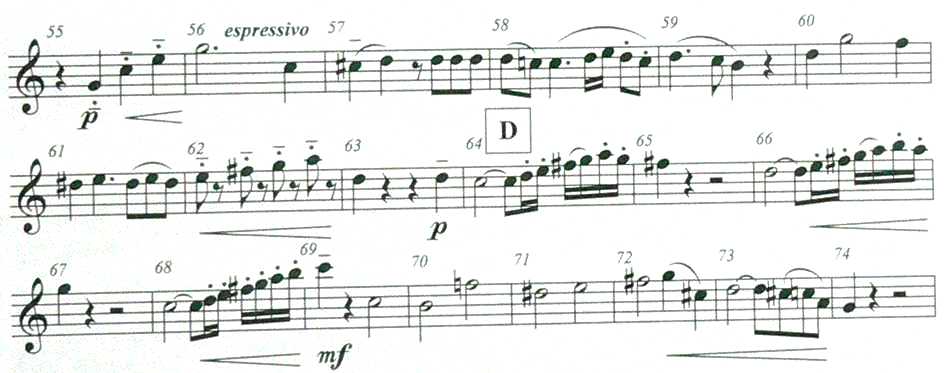|
3eme Concerto pour le Cor op.106 (K.495) |
Ein Waldhorn Konzert für den Leitgeb |
|
How to play this concert |
Interpretationsanleitung pg.2 |
|
|
|
|
You deserve the short rest here, but the first solo is not finished yet. Come with the three "up bow" 1/4-notes carefully, setting the 3/4 f2 with T1 & emphasize the bnat1 with a light "tenuto", the following three 1/8 notes c2 (written as d2) light "getupft" ("up bow"), emphasize on the succeeding c2 & perform the sixteenths in M.58 very light on the F-side & do not shorten the endnote a1 too much. If you have difficulties performing these light sixteenths, well, fingering the d1 with F1 would not bother me, if it works fine for you.. Yeah, I forgot to mention, that the last note of M.59 should be tongued also. The next M.60 starts on F-side but continues on the Bb-side all on first valve, to switch to the F-side for the entire M.61 (c# with 2, d with F0). The separated 1/8 notes with the light crescendo are "up bow" again & the downbeat c in M.63 is to be well set, as well as the following upbeat c2. But switch here to the Bb-side for clarity. T1 will help you to get the g2 right on. Start M.66 with a crescendo, but not too much. Fingering g2 with T1 help here also, and a crescendo again for the top run, settling yourself well on the high bb2. Here the last run would flow better if the e2-f2 are slurred the same way as in the preceding measures. The end of the phrase, you know the sequence of half notes is very fine on the F-side, the down-slur f2 - bnat1 could be very sweet, just gliding down & finish with a light crescendo to the ending f1. |
Ja, natürlich braucht man hier eine Pause. Das erste Solo ist aber noch nicht zu Ende. Komm mit drei "Aufstrich-Vierteln" und setze die Dreiviertelnote f2 schön mit T1. das folgende h schön im tenuto und die folgenden drei Achtel c2 (als d2 notiert) leicht getupft (Aufstrich) , eine leichte Betonung auf das c2. Die Sechzehntel ganz leicht auf dem F-Horn (T.58), die Endnote a1 nicht zu kurz. wenn Du Schwierigkeiten mit den leichten sechzehntel hast, also, das d2 mit dem 1.Ventil störte mich nicht. Oh, ich habe vergesse, das man den letzten Ton der Phrase in T.59 ruhig mit der Zunge anschieben sollte. T.60 beginnt auf der F-Seite, wird aber sofort auf dem B-Horn fortgesetzt, u.z. mit T1, und wieder für den ganzen T.61 aufs F-Horn zurück (cis mit 2, d mit 0). Die leicht abgesetzten Achtel sind wieder "Aufstrich" aber mit leichtem crescendo. Der Niederstreich c in T.63 muss ganz genau sitzen, ebenso der folgende c2 Auftakt: wechsle hier aber wegen der Klarheit besser zum B-Horn. T1 hilft für das g2 (ausnahmsweise). Beginne T.66 mit einem vorsichtigen crescendo. Auch hier hilft T1 für das g2, und noch ein crescendo ganz hinauf zum b2. Der Lauf gelingt besser, wenn auch hier e & f wie in den vorhergehenden Takten gebunden werden . Das Ende der Phrase, also die Folge der halben Noten, ist auf der F-Seite sehr schön auszuführen, die Bindung f2-h sehr süss, nur hinuntergleiten und mit einem leichten crescendo zum Abschluss f1. |
|
|
|
